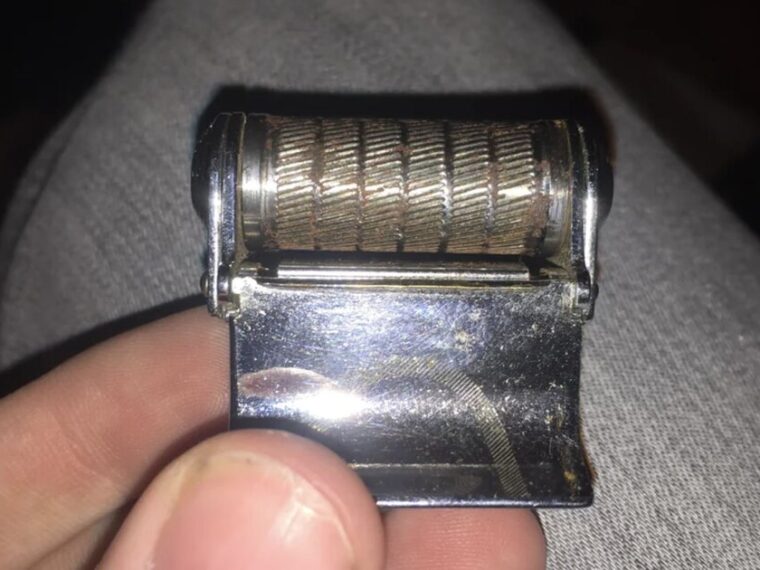What you’ve uncovered is a Rally Dry Shaver — a remarkable relic from a fascinating chapter in shaving history. At first glance, it might seem like an odd contraption, a miniaturized lawn mower designed for your face. But the Rally Dry Shaver was actually part of a bold experiment to revolutionize the way men shaved, breaking away from centuries of tradition.
The Rally Dry Shaver: A Brief Introduction
Unlike conventional razors, which rely on sharp blades to slice through hair, the Rally Dry Shaver used a toothed rolling cylinder to shear facial hair mechanically. Imagine rolling a tiny cylinder covered in blades or teeth over your skin, much like a mini lawn mower gliding over a lawn, clipping the grass as it goes. This was the concept behind the Rally Dry Shaver.
The idea was simple but revolutionary: to provide a dry shaving experience that required no water, no soap, and no shaving cream. It promised a quick, convenient way to shave on the go — perfect for busy men who didn’t want to fuss with the messy process of traditional wet shaving.
Breaking from Tradition: The History of Shaving
For thousands of years, shaving was a wet process. Men used sharp stones, shells, or metal blades to carefully remove their facial hair. By the 19th century, straight razors were common, requiring skill, care, and a good deal of time. Then came the safety razor in the early 20th century, which made shaving safer and easier for the average person.
The Rally Dry Shaver challenged this long history. Instead of slicing the hair at the surface, it mechanically clipped the hair with a rotating cylinder, without any water or cream. This concept was part of a broader mid-20th century movement aimed at making personal grooming faster, simpler, and more convenient.
The Design of the Rally Dry Shaver
The Rally Dry Shaver consisted of a handheld device with a small rotating cylinder covered in sharp, toothed blades. This cylinder was powered either by a manual mechanism or a small motor, depending on the model. As you rolled the shaver across your face, the rotating teeth would catch and shear the hair at the surface.
The design was compact, making it easy to carry while traveling. The absence of water or shaving cream meant it could be used anywhere — from office desks to camping trips. It was an appealing option for men who valued speed and convenience.
The device was constructed with durable metals and plastics, designed to withstand daily use. The rolling mechanism was carefully engineered to provide a consistent shave without pulling or irritating the skin — though many users reported mixed experiences.
Why Didn’t the Rally Dry Shaver Catch On?
Despite its innovative design and promise of convenience, the Rally Dry Shaver never achieved widespread popularity. There are several reasons why:
1. Shave Quality:
Compared to traditional razors and even the emerging electric shavers, the Rally Dry Shaver struggled to deliver a close, smooth shave. Because it worked by clipping rather than slicing hair at the root, many users found the results less satisfying, with stubble left behind.
2. Comfort and Skin Sensitivity:
The mechanical teeth could be harsh on sensitive skin. Users often reported irritation, redness, or even minor cuts. In contrast, safety razors and electric shavers were becoming gentler, more ergonomic, and better suited for daily use.
3. Competition from Electric Shavers:
Electric shavers were improving rapidly in the mid-20th century. Brands like Philips and Remington introduced foil and rotary shavers that were quieter, faster, and provided closer shaves. These devices often included built-in motors, rechargeable batteries, and innovative blade designs that outperformed the Rally Dry Shaver.
4. Market Awareness and Marketing:
The Rally Dry Shaver was never heavily promoted or widely distributed. It remained a niche product, available in limited markets, which hampered its ability to gain traction against established shaving brands.
The Rally Dry Shaver in the Context of Shaving Innovation
The Rally Dry Shaver is an intriguing example of mid-century innovation and experimentation. At a time when technology was rapidly advancing, inventors sought to rethink everyday tasks — shaving included.
While it may not have been a commercial success, the device represents a key moment in the evolution of grooming technology. It bridged the gap between manual razors and modern electric shavers, exploring new ways to remove hair with speed and convenience.
In fact, the concept of mechanical shearing inspired future developments in personal grooming tools. Today’s electric trimmers and rotary shavers owe much to the pioneering spirit embodied by devices like the Rally Dry Shaver.
How the Rally Dry Shaver Worked: A Closer Look
Mechanically, the shaver worked by turning the cylinder’s teeth against the hair. The rolling motion allowed for continuous cutting as you moved the device along your face.
Unlike blades that slice hair at the skin’s surface, the shearing action clipped the hair just above the skin, which often left a slight stubble. While some users appreciated the “five o’clock shadow” effect, others preferred a cleaner finish.
The manual models required hand cranking or shaking to spin the cylinder, while motorized versions offered electric power, making the process smoother and less labor-intensive.
Cleaning the device involved removing the cylinder and clearing trapped hairs, much like modern electric shavers. Maintenance was crucial to ensure the teeth remained sharp and the mechanism operated smoothly.
Cultural and Social Impact
In the era when the Rally Dry Shaver emerged, shaving was not just about personal hygiene; it was deeply tied to masculinity and social norms. A clean-shaven face was a symbol of professionalism, neatness, and modernity.
By offering a dry, portable shaving option, the Rally Dry Shaver challenged traditional routines and rituals associated with shaving. It appealed especially to younger, urban men who wanted to embrace a faster-paced lifestyle without sacrificing appearance.
Although it didn’t become mainstream, the Rally Dry Shaver reflected the cultural shift toward convenience and innovation in personal care — trends that continue to shape grooming products today.
Modern-Day Collectors and Enthusiasts
Today, the Rally Dry Shaver is a collectible item among vintage shaving aficionados and retro technology enthusiasts. Its unique design and story make it a conversation starter and a testament to mid-century ingenuity.
Collectors prize well-preserved models for their rarity and historical significance. Some vintage shops and online marketplaces occasionally list Rally Dry Shavers, drawing interest from those fascinated by the evolution of grooming tools.
Enthusiasts often share restoration tips, historical information, and personal experiences online, keeping the legacy of this quirky device alive.
Lessons from the Rally Dry Shaver
The Rally Dry Shaver’s journey offers several valuable lessons about innovation:
- Not Every Idea Succeeds, But Every Idea Matters: Even if a product doesn’t dominate the market, it can influence future designs and push boundaries.
- User Experience is Key: Technology must not only be innovative but also comfortable, effective, and easy to use.
- Timing and Marketing Matter: Great inventions need strong promotion and market readiness to thrive.
- Simplicity vs. Performance: Sometimes simple concepts don’t perform well enough to replace established methods, especially in personal care.
The Rally Dry Shaver’s Place in Shaving History
While the Rally Dry Shaver didn’t transform grooming habits, it remains a fascinating footnote in the history of shaving technology. It sits alongside other innovative attempts to modernize and improve personal care, such as electric shavers, disposable razors, and multi-blade cartridges.
In retrospect, the Rally Dry Shaver embodies the spirit of experimentation that drives progress. It dared to challenge conventions and paved the way for the sophisticated grooming devices we rely on today.
Final Thoughts: More Than Meets the Eye
Next time you spot a Rally Dry Shaver at a flea market, antique shop, or inherited from a relative, remember: this simple device is more than just a curiosity. It’s a piece of revolutionary design thinking, a testament to human ingenuity and the quest to simplify everyday life.
Though it never became a household staple, the Rally Dry Shaver carved out its place in history as a bold experiment — a rolling reminder that innovation often begins with a simple idea, rolled forward with hope and vision.





